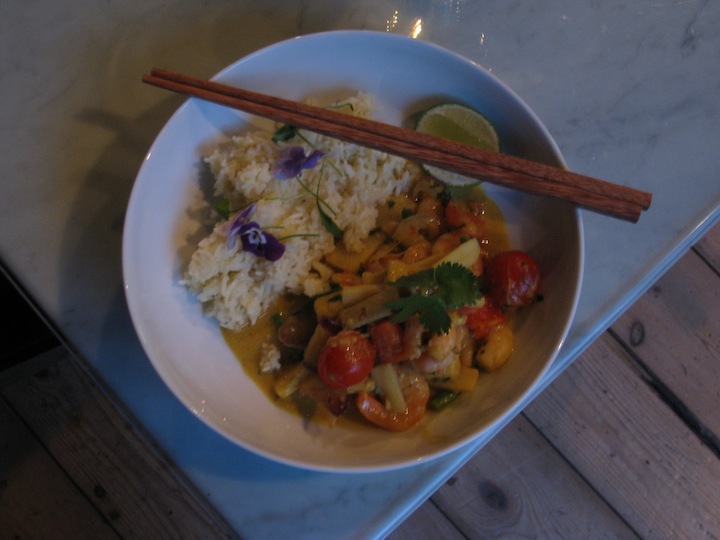A combination of a thoughtful friend and corporate marketing generosity led me to eat dinner last week in a lovely space more usually used for photography shoots. A dozen of us arrived for an event which far surpassed its somewhat unpromising invitation. (A “new range of meal solutions” are not words which should be allowed out into the wild, for starters.)
We were greeted with cocktails made by a flair-wielding bartender, and by representatives of the marketing agency and the brand, Lyons Seafoods, whose products were the evening’s centerpiece. Gorgeous, towering displays in vases of vegetables represented each of the four dishes being launched. The vegetable display was a genius idea on someone’s part. Our conversations looped regularly back around to how impressive and well-done they were.

This was not a meal which began with eating – although there were nibbles to go with our cocktails – but with cooking. We each chose a dish and a chef equipped with a plethora of woks cooked them up, one variety at a time. It doubled as a group deduction as to why professional chefs so often do not use stirring spoons when a home chef would: spoons would carry contaminants from raw to cooked phases of a dish.Also, cooking lots of dishes at once can easily result in spoon-confusion. (I came home and have been practicing tossing my food about in pots ever since. Only one minor disaster so far.)
Along with two others, I opted for the modestly-spicy Malaysian prawn laksa. After being cooked, a food stylist took over for plating and decorating. Our tidy piles of rice and laksa were scattered with micro-coriander and pretty purple violas. A slice of lime completed the presentation.

Since we were sent home with all four of the feeds-two-each quick-cooking variants to try, I can tell you about their commonalities. The meals are designed as easy-to-cook, refridgerated compartments of pre-cut vegetables, fish and/or prawns, and a sauce sachet. None of them are meant to take more than 6 minutes to cook, and none of them did. Admirable attention has been put into texture and color contrast, with all of them featuring a good variety of both. They’re all well-rounded, with enough meat and vegetables built-in for a comfortable portion size. (Not ample; comfortable.)
Of course a lot of thought was put into the design of these meals, but that was brought home in hearing of some of the other tasty dishes developed in early stages of the line which didn’t look to have enough of a market in the UK to make them worth launching. American classics of chowder and jambalaya, for example, did not make the final cut; at least, not for the launch.
My favorite of the four was the Catalan fish stew, whose taste dimensions were rounded out by thin slices of cured chorizo. It’s also the only one with neither gluten nor dairy products among the ingredients.
The Kerala curry had a touch of dairy in the sauce, but no gluten. The Thai sweet chili king prawns had personality, though no real heat; still, it was no rollover dish. It had presence, and I didn’t mind at all eating it for two meals in a row, as ended up happening.
The consensus among the various people I ate these meals with was that they’re solid choices, good food worth eating when an easy-to-cook meal is the right choice. One friend observed her price point for these was right where the introductory offer put them, at £4.99 each.
For now, the Lyons Seafoods dinners are only available in the UK’s 150 largest Sainsburys.
P.S. I have no good etymological source for “laksa”, but it may either come from a kind of noodle whose name, in turn, derives from the Sanskrit “lakshas”, or a hundred thousand; or it dervies from the Cantonese “spicy sand”, for grit of the ground dried prawns in the sauce. I quite like the idea of a stew named after a large number.
 © S. Worthen 2009
© S. Worthen 2009